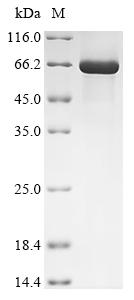The recombinant human coagulation factor X (F10) protein labeled with an N-terminal 6xHis tag and C-terminal Myc-tag is expressed in an E. coli system. The coagulation factor X gene fragment (41-488aa) is co-cloned into a suitable expression vector with the tag gene and then introduced into E. coli cells. IPTG is used to induce expression of the recombinant coagulation factor X protein, which is then extracted through cell lysis. The coagulation factor X protein is purified by Ni-NTA affinity chromatography, exploiting the His tag’s affinity for nickel ions. Following purification, the protein is analyzed using SDS-PAGE, which demonstrates a purity greater than 90%.
Human coagulation factor X (FX) is a crucial component of the blood coagulation cascade, functioning as a vitamin K-dependent serine protease. It is synthesized in the liver as a zymogen (inactive form) and plays a pivotal role in both the intrinsic and extrinsic pathways of coagulation, ultimately leading to the formation of thrombin from prothrombin [1][2]. Upon activation, FX is converted to activated FXa, which catalyzes the conversion of prothrombin into thrombin, a key enzyme in the coagulation process that facilitates the transformation of fibrinogen into fibrin, thus forming a stable blood clot [3][4].
The activation of FX is a critical juncture in hemostasis, as it integrates signals from both the intrinsic and extrinsic pathways. The extrinsic pathway is initiated by the exposure of tissue factor (TF) at the site of vascular injury, which forms a complex with factor VIIa, leading to the activation of FX [5][6]. This process is essential for a rapid hemostatic response to vascular damage, as FXa subsequently activates thrombin, amplifying the coagulation response [1][7]. Additionally, FX is involved in various regulatory mechanisms that ensure the balance between coagulation and fibrinolysis, preventing excessive clot formation or bleeding [8][9].
References:
[1] J. Wilberding, Characterization of the murine coagulation factor x promoter, Thrombosis and Haemostasis, vol. 84, no. 12, p. 1031-1038, 2000. https://doi.org/10.1055/s-0037-1614167
[2] D. Venkateswarlu, L. Perera, T. Darden, & L. Pedersen, Structure and dynamics of zymogen human blood coagulation factor x, Biophysical Journal, vol. 82, no. 3, p. 1190-1206, 2002. https://doi.org/10.1016/s0006-3495(02)75476-3
[3] S. Ebrahimi, S. Rezaei, P. Seiri, M. Ryzhikov, & S. Hashemy, Factor xa signaling contributes to the pathogenesis of inflammatory diseases, Journal of Cellular Physiology, vol. 232, no. 8, p. 1966-1970, 2016. https://doi.org/10.1002/jcp.25714
[4] A. Yamashita and Y. Asada, Underlying mechanisms of thrombus formation/growth in atherothrombosis and deep vein thrombosis, Pathology International, vol. 73, no. 2, p. 65-80, 2023. https://doi.org/10.1111/pin.13305
[5] U. Ohto, R. Mizutani, M. Nakamura, H. Adachi, & Y. Satow, Crystal structure of a humanized fab fragment of anti-tissue-factor antibody in complex with tissue factor, Journal of Synchrotron Radiation, vol. 11, no. 1, p. 105-108, 2003. https://doi.org/10.1107/s0909049503023513
[6] S. Day, J. Reeve, B. Pedersen, D. Farris, D. Myers, M. Im, et al. Macrovascular thrombosis is driven by tissue factor derived primarily from the blood vessel wall, Blood, vol. 105, no. 1, p. 192-198, 2005. https://doi.org/10.1182/blood-2004-06-2225
[7] N. Nn, R. R, V. Ms, & A. Anogeianaki, Effects of the hormones of the thyroid axis on the vitamin k-dependent plasma factors of blood coagulation (ii, vii, ix and x), International Journal of Immunopathology and Pharmacology, vol. 21, no. 1, p. 221-226, 2008. https://doi.org/10.1177/039463200802100125
[8] S. Ichikawa, K. Saito, N. Fukuhara, Y. Tanaka, Y. Lee, K. Onodera, et al. Successful treatment of life-threatening bleeding caused by acquired factor x deficiency associated with respiratory infection, Internal Medicine, vol. 59, no. 10, p. 1303-1308, 2020. https://doi.org/10.2169/internalmedicine.4142-19
[9] M. Schuliga, The inflammatory actions of coagulant and fibrinolytic proteases in disease, Mediators of Inflammation, vol. 2015, no. 1, 2015. https://doi.org/10.1155/2015/437695




